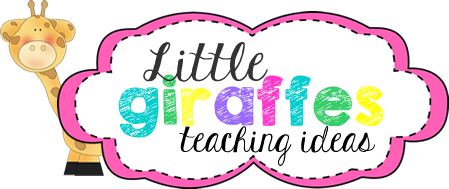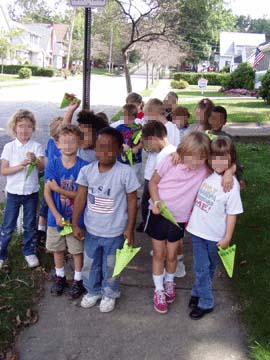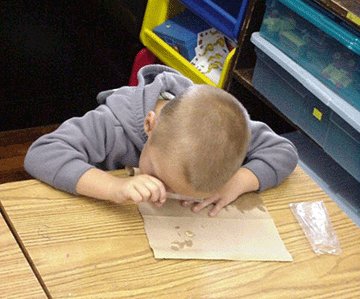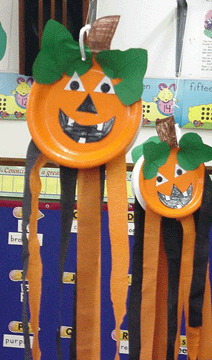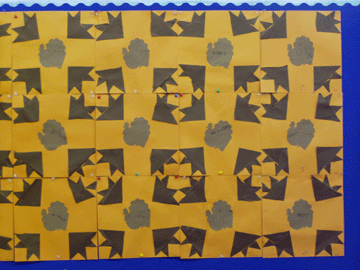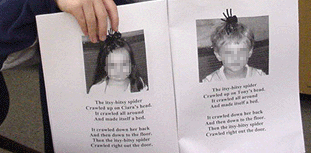Touch
Place six different shaped objects in six socks which have been labeled with numerals. Have students divide a paper into 6 boxes and number them. Pass the socks around and have the students make a picture of what they think is inside from feeling them. Take out the objects and compare the drawings to the actual objects.
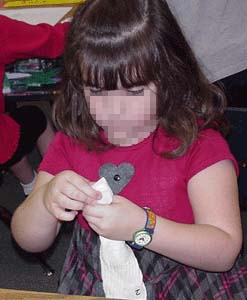

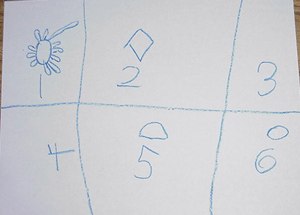
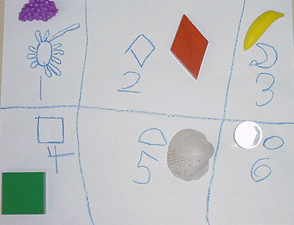
You could also have drawings of numbered socks.
Make a book or picture using different textured fabric (net, felt, fur) or other objects (sandpaper, buttons, cotton balls.)
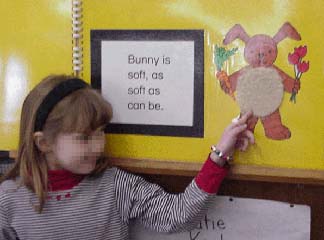
We read a book titled, “Our Hands” by Aliki. We tried to see how long we could go without using our hands. We only lasted about 2 minutes!

What’s in the mystery bag? How did it feel? Was it squishy, yukky, hard, soft, smooth or rough? Fill platick bags with different textured materials and then place the plastic bag inside lunch bags to hide them. Some suggestions are cold cooked spaghetti, whipped cream or shaving cream, jello, rocks, popcorn, pudding, toothpaste, mashed bananas, fur fabric and ice cubes. Keep those wipes handy! This boy seems to like this one–I guess it wasn’t the bag of worms! ;o)
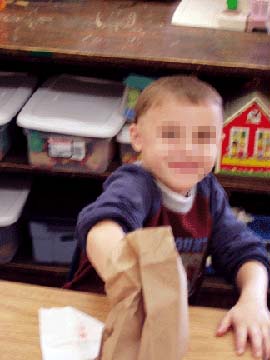
Sight
These glasses have colored lenses to observe if objects change color when looking through colored lenses.
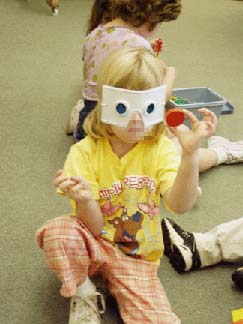
But the same effect can be achieved by rubber-banding colored cellophane over toilet paper tubes. When a student looks through a red lens at a blue block, does it appear to be purple?
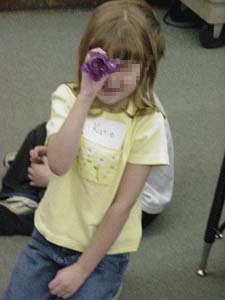
Use a magnifying glass or a lighted microscope to take a closer look at everyday objects. Don’t forget to look at your clothes and skin!
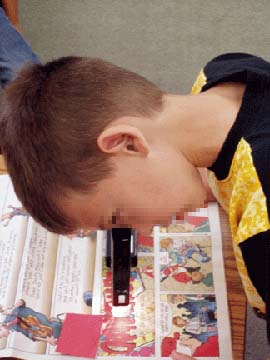
Place about 10 common objects on a tray. Show each one to the class; hide the tray and remove one object. See if the students can remember which object is missing.
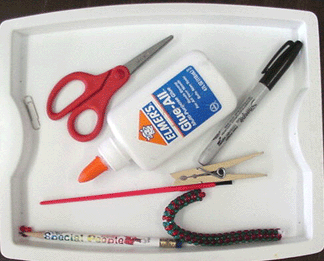
Discuss the parts of the human eye and have students look at each other’s eyes. Tell them that the pupil of their eyes gets larger to let light in when it is dark and becomes smaller when there is a lot of light. Assign them a partner and have them look at their partner’s pupil. Darken the room by turning off lights and pulling shades. Have the children get in position to view each other’s pupils. Turn on the lights and the students will be amazed when their partner’s pupils change size from large to small. They love it!
Hearing
Have one group of students lay on the floor with one ear to the ground while the other group jumps up and down to feel and hear the vibrations.

Ask students to put their hand over their throat. Then have them whisper, talk, yell, hum, etc. to feel the vibrations of their larynx.
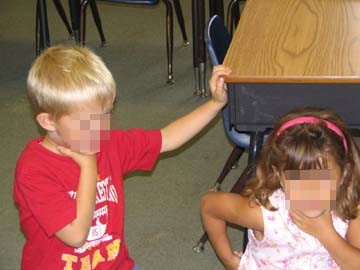
This is one of my favorites to illustrate that vibrations cause sound. Use a rubber band to attach a piece of thin rubber (a piece of a balloon or rubber glove) to one side of a PVC elbow. Put a few pieces of rice on the taut piece of rubber. Talk into the open end of the PVC pipe and watch the rice dance (sound waves). The louder you talk, the better the rice jumps.
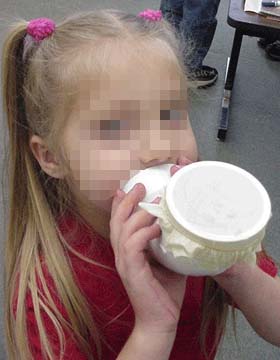
Demonstrate vibrations making sounds by running your finger across a comb and by playing a “finger guitar” (three nails pounded into a piece of wood with different width rubber bands.)
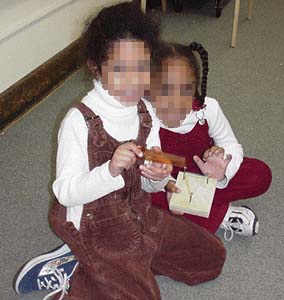
Students are fascinated when they can hear the hum of a tuning fork after striking it with a rubber mallet.

Remember the old tin can telephones??? You can do the same thing using clear plastic cups.
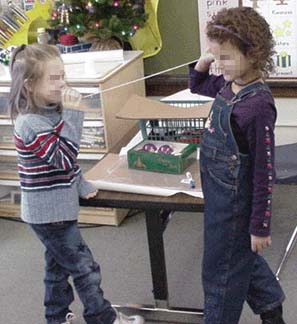
Place small objects (pins, nails, rice, buttons) in pairs of empty film canisters. Have students try to find the matching sounds when they shake them.

Use class instruments to observe vibrations.
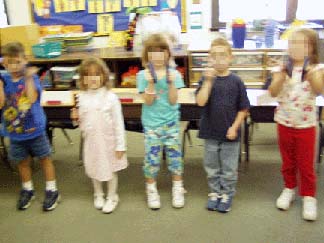
He is listening to the vibrations of the comb’s teeth when he runs his fingers over them.

Make a duck from a paper cup that “quacks” by running a wet sponge down the string. Punch 2 small holes in the bottom of a yellow plastic cup and tie a long string through the holes. Tie a small piece of sponge to the other end of the string. Add a construction paper beak to the cup. Wet the sponge and pull it down the string to make a quacking sound.
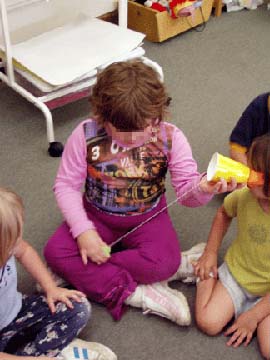
Make a shoebox guitar to strum. The different rubber bands widths make some sounds higher and some sounds lower.
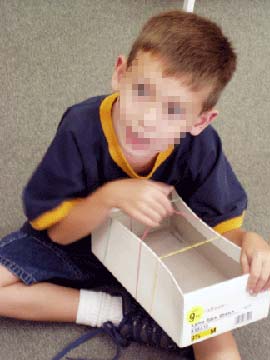
Each child brought an object from home to make a “secret sound.” They stood behind a chart stand so we couldn’t see what was making their sound. We tried to guess what object was being used to make the sound.
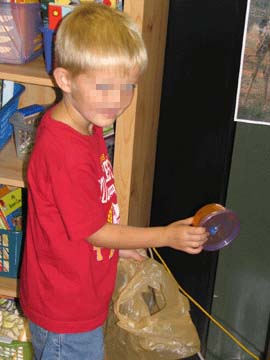
Assign “family homework” of making an instrument. Have students bring them in and play them in a class band—bring some Tylenol that day! :o) March around the room playing the instruments. We also used them for counting practice–I wrote a number and they tapped that many beats. Another idea is to use them for audio patterns. Divide the class into groups named A, B or C. Have each group participate in making an ABC pattern by playing their instruments at the appropriate time in the pattern.
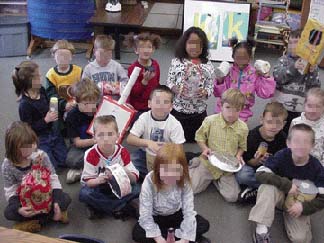
Smell
Put different scented materials into containers (put numbers on the bottom to identify them) with holes in the top. (Wet a cotton ball and sprinkle the materials over the wet cotton ball to enhance the smell.) Do two the same and students can match the same scents. Students can simply try to identify the scent. Or sort the containers into good smells (peanut butter, oranges, mint) and bad smells (onion, garlic).
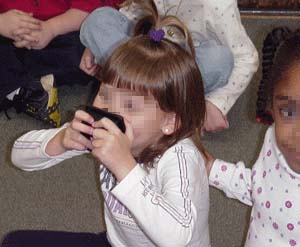
Sort the containers into good smells (peanut butter, oranges, mint) and bad smells (onion, garlic). Can you guess which kind of smell was in this container?
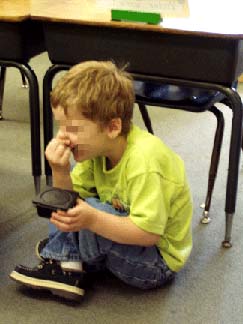
Do two the same and students can match the same scents. Students can simply try to identify the scent.
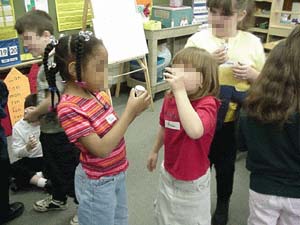
Cut a gingerbread man shape out of sandpaper. Rub a cinnamon stick over the sandpaper–mmmm!
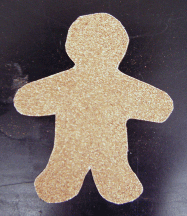
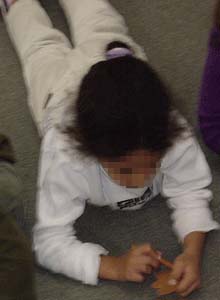
Place different colored jelly beans in three different bags (all red in bag 1….) Use a blindfold (or have students close their eyes and you put the jelly beans in their mouths). Do this for each bag. Students hold their nose and chew a jellybean without smelling or seeing it. They record what color they predict the bean was on a recording sheet such as the one seen here. Then have students taste the same color jelly bean without holding their noses (but still not able to see it) Mark the prediction in the second recording box. Show the students the bean and have them color in the correct answer. Do the same for the other two bags.
This activity is from a site no longer online, but some has been archived here: Jelly Bean Jumble.
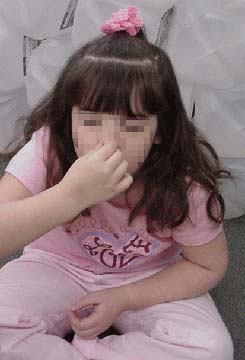
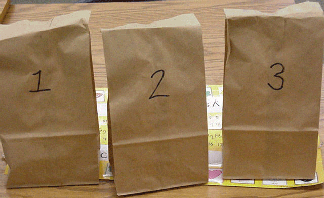
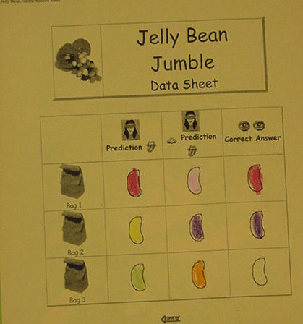
Taste
Look at the small bumps (taste buds) on each others’ tongues. Try tasting a sweet (orange slice with sugar coating), sour (lemon or dill pickle), bitter (unsweetened chocolate), and salty (pretzel or Frito) food and finding the place on the tongue where that type of food is best tasted. Show a “tongue map” if you can find one.

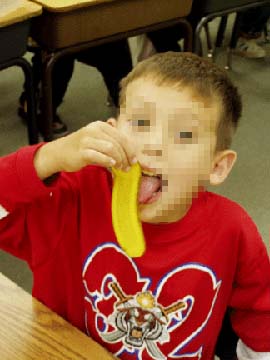
Foods that look alike do not always taste the same. We used our sense of taste to discover which powder was sugar and which was salt.
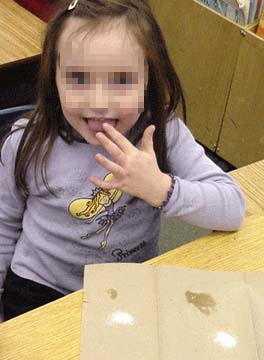
You can tell the difference between salt and sugar if you observe them under a microscope.
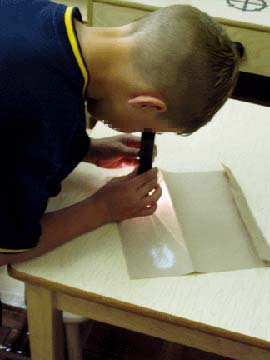
Which fruit piece is an apple and which is a pear?

Other Ideas

As a culmination to your five senses unit, have the children make self portraits; then glue on wiggle eyes, cotton ball dipped in perfume (nose), jingle bells (ears), sand paper (hands) and licorice (mouth). Use this caption:
“_____________ has Five Senses”.
Five Senses Festival
Have a Five Senses Festival as a culminating activity to your Five Senses unit. Set up five stations:
Station 1: Play a memory game OR have a tray of about ten objects and take one away. See if the students can remember which one is missing.
Station 2: Listen to a tape of various sounds and try to identify the sound OR do the sound matching activity above.
Station 3: Eat popcorn.
Station 4: Do one of the smell activities mentioned above.
Station 5: With parental help, blindfold one child at a time, take off his shoes and socks, and take him into the hall to walk through trays of different textured materials: cottonballs, stones, popped popcorn, cold cooked spahetti and warm water. Ask the children to verbalize how each material feels.
